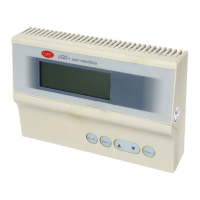8. Ricerca ed eliminazione guasti
L’unità non si avvia (LED sulla scheda base di presenza rete spen-
to, LCD spento,
altri LED spenti)
Verificare:
1. presenza tensione di rete;
2. che a valle del trasformatore di tensione di alimentazione vi siano
24 Vac/Vdc;
3. il corretto inserimento del connettore di alimentazione a
24 Vac/Vdc nell’apposito supporto;
4. che il fusibile di protezione sia integro;
5. che il cavo telefonico di connessione tra terminale (se presente)
e scheda base sia collegato correttamente.
All’accensione si presenta una situazione del tipo
• LED di allarme acceso;
• LCD senza alcuna scritta o con scritte casuali;
• cicalino attivo.
Verificare:
1. corretto inserimento EPROM;
2. che non siano stati piegati i piedini nell’inserimento della EPROM;
3. che non sia stato manomesso il chip microprocessore:
in tal caso chiamare l’assistenza.
Letture errate dei segnali in ingresso
Verificare:
1. l’eventuale taratura degli ingressi (da programma);
2. la corretta alimentazione della scheda base e delle sonde;
3. la separazione dell’alimentazione degli ingressi digitali
dall’alimentazione del pCO. Può essere utilizzato un trasformatore
24 Vac/24 Vac da 12 VA.
4. che la connessione dei fili delle sonde sia secondo istruzioni
5. che i cavi delle sonde siano posizionati a sufficiente distanza da
possibili fonti di disturbo elettromagnetico (cavi di potenza,
contattori, cavi con alte tensioni e con dispositivi collegati ad alto
assorbimento allo spunto);
6. che tra sensore ed eventuale pozzetto sonda non vi sia un’alta
resistenza termica. Eventualmente inserire nei pozzetti pasta o olio
conduttivo per garantire una buona trasmissione della temperatura;
7. se si è in presenza di errore di sonda oppure se si tratta di un
errore di conversione del pCO, le verifiche si diversificano a
seconda del tipo di sonda:
Sonde attiv
e di temperatura/umidità con segnale -0,5 V÷1 V:
misurando con un voltmetro tra i morsetti Bn ed AVSS si ha il
segnale di sonda e si puó verificare la corrispondenza tra tensione
e grandezza: 1 mVdc corrisponde a 0,1°C
Esempio: leggendo 200 mVdc (0,2 Vdc) la sonda invia un segnale
che corrisponde a 20°C/20%U.R.; applicando la stessa logica a
0 mVdc corrispondono a 0ºC/0% U.R.;
Sonde di pressione:
nel caso emergano errori nella lettura di
queste sonde verificare che:
• gli ingressi analogici di tali sonde siano predisposti per accettare
segnali 4÷20 mA;
• i fondoscala impostati via software corrispondano alle sonde
impiegate.
Misurando con un voltmetro la tensione presente ai capi dei
morsetti Bn ed AVSS si ottiene indirettamente la corrente del
segnale di sonda, in quanto l’ingresso ha una impedenza di 50 Ω,
applicando la formula I=V/R.
Il valore di pressione “Ps” che la sonda sta inviando è così
ricavabile (FS=Fondo Scala):
Ps = (Vmis/50 - 0,004) x (FSmax - FSmin) / 0,016 + Fsmin
Esempio: la sonda impiegata ha FSmin=-0,5 bar, FSmax=7 bar;
la tensione letta è pari a Vmis= 0,5 Vdc.
La pressione Ps che la sonda sta misurando vale:
Ps = (0,5/50 - 0,004) x [7 - (-0,5)] / 0,016 + (-0,5)=2,3 bar
8.Troubleshooting
The unit does not switch on (the LED on the main board signalling
network presence is off
, the LCD is off,
other LEDs are off)
Check:
1. the presence of main power;
2. that the output voltage of the power transformer is 24Vac/Vdc;
3. that the 24Vac/Vdc power connector is correctly inserted;
4. that the overload fuse is in tact;
5. that the telephone-type cable connecting the terminal (if present)
and the main board is correctly connected.
On s
witching on one of these situations occurs
• the alarm LED is on;
• the LCD is blank or displays random characters;
• the buzzer is on.
Check:
1. that the is EPROM correctly inserted
2. that the pins of the EPROM were not bent when it was inserted;
3. that the microprocessor chip has not been tampered with:
if so, call the service department.
Err
oneous reading of the input signals
Check:
1. the calibration of the inputs (from the program);
2. the correct power to the main board and the probes;
3. that the power to the digital inputs and power to the pCO are
separated.A 24Vac/24Vac, 12VA transformer can be used.
4. that the connection to the wires from the probes is as per the
instructions;
5. that the probe cables are located far enough away from possible
sources of electromagnetic disturbance (power cables, contactors,
high-voltage cables or cables connected to devices with high peak
absorption);
6. that there is not a high degree of heat resistance between the
sensor and the probe cap (if present). If necessary introduce
conductive paste or oil into the caps to ensure good temperature
transfer;
7. if there is a probe error or pCO conversion error, the checks to be
carried out vary according to the type of probe:
Activ
e temperature/humidity probes with -0.5V÷1V signal:
measure, using a voltmeter between terminals Bn and AVSS, the
probe signal and check that the voltage corresponds to the
temperature/humidity value: 1mVdc corresponds to 0.1°C
Example: reading 200mVdc (0.2Vdc), the probe sends a signal
which corresponds to 20°C/20%r.H.; using the same logic, 0mVdc
corresponds to 0ºC/0% r.H.;
Pressure probes:
if there are errors in reading these probes,
check that:
• the analogue inputs from these probes are set to receive signals
of 4÷20mA;
• the full scale set by the software corresponds to that of the
probes used.
By measuring the voltage between Bn and AVSS, the current of
the probe signal can be easily calculated, considering that the
input has an impedance of 50Ω, applying the formula I=V/R.
The pressure value “Ps” sent by the probe can be calculated as
follows (FS=Full Scale):
Ps = (Vread/50 - 0.004) x (FSmax - FSmin) / 0.016 + Fsmin
Example: the probe used has a FSmin=-0.5bar, FSmax=7bar;
the voltage read is Vread= 0.5Vdc.
The pressure Ps that the probe is measuring is thus:
Ps = (0.5/50 - 0.004) x [7 - (-0.5)] / 0.016 + (-0.5)=2.3bar
29

